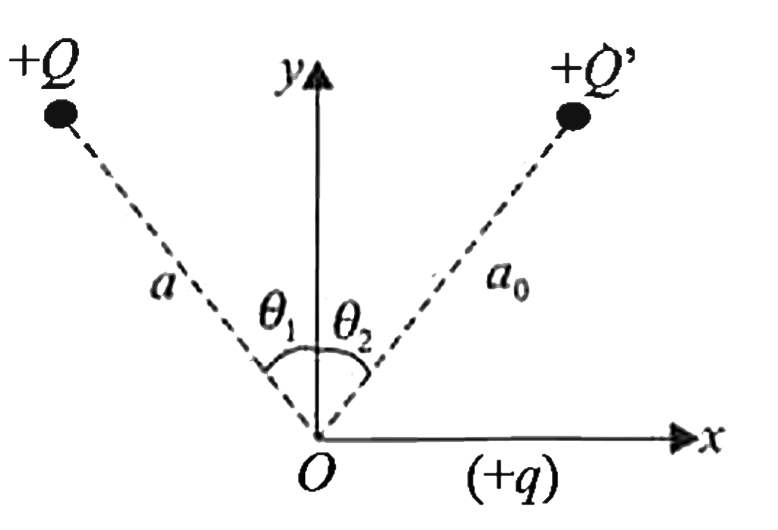Charges 4Q, q and Q and placed along x-axis at positions x=0,x=1/2 and x=1, respectively. Find the value of q so that force on charge Q is zero
−q
−2q
−q2
4q
The correct Answer is:A
Step by step video, text & image solution for Charges 4Q, q and Q and placed along x-axis at positions x=0,x=1//2 and x=1, respectively. Find the value of q so that force on charge Q is zero by Physics experts to help you in doubts & scoring excellent marks in Class 12 exams.
Topper's Solved these Questions
- BOOK - NARAYNACHAPTER - ELECTRIC CHARGES AND FIELDSEXERCISE - EVALUATE YOURSELF-29videos
ELECTRIC CHARGES AND FIELDS
- BOOK - NARAYNACHAPTER - ELECTRIC CHARGES AND FIELDSEXERCISE - EVALUATE YOURSELF-37videos
ELECTRIC CHARGES AND FIELDS
- BOOK - NARAYNACHAPTER - ELECTRIC CHARGES AND FIELDSEXERCISE - EXERCISE -443videos
ELECTRIC CHARGES AND FIELDS
- BOOK - NARAYNACHAPTER - DUAL NATUREEXERCISE - LEVEL-II (H.W)17videos
DUAL NATURE
- BOOK - NARAYNACHAPTER - ELECTRO MAGNETIC INDUCTIONEXERCISE - Level-II (H.W)23videos
ELECTRO MAGNETIC INDUCTION
Similar Questions
Point charges q1 and q2 lie o the x-axis at points x=−a and x=+a respectively.
a. How must q1 and q2 be related for the net electrostatic force on point charge +Q, placed at x=+a2, to be zero?
b. With the same point charge +Q now placed ate x=+3a/2View Solution(a) Two point charges Q and 16Q are fixed at separation d. Where should a third point charge be placed between them so that it experiences no force I.e. in equilibrium ?
(b) In the previous problem , if we replace Q by −Q , where should the third charge be placed on the joining the charges so that it is equilibrium ?
(c ) Three point charges Q,q and Q are placed at x=0,x=d/2 and x=d. Find q in terms of Q so that all charges are in equilibrium.
(d) Two point charges 9Q and 25Q are placed at separation d. Where should a third charge q be placed between them so that all charges are in equilibrium ? Also find the value of q and its nature.View Solution
Knowledge Check
- Question 1 - Select One
Charges 4Q, q and Q and placed along x-axis at positions x=0,x=t/2 and x=1, respectively. Find the value of q so that force on charge Q is zero
AQBQ/2C−Q/2D−Q - Question 2 - Select One
Point charges +4q,−q and +4q are kept on the x-axis at points x=0,x=a and X=2a respectively, then
AOnly q is in stable equilibriumBNone of the charges are in equilibriumCAll the charges are in unstable equilibriumDAll the charges are in stable equlibrium - Question 3 - Select One
Point charges +4q,−q are kept on the x-axis at points x=0,x=a and X=2a respectively, then
AOnly q is in stable equilibriumBNone of the charges are in equilibriumCAll the charges are in unstable equilibriumDAll the charges are in stable equilibrium
An infinite number of charges, each equal to q, are placed along the x -axis at x=1,x=2,x=4,x=8, etc. The electric field at the point x=0 due to the set of charges is qnπɛ0. Find n.
View SolutionThree charges 4q,Q and q are in a straight line in the position of 0.l/2 and l respectively. The resultant force on q will be zero, if Q=
View SolutionIn the configuration as shown +q charge is placed at origin and Q and Q are placed at distance a and a0 respectively from origin. If net electrostatic force on charge (+q) is along negative y-axis and θ=θ2/2, then (Q/Q) is equal to:
 View Solution
View SolutionCharges Q−q,Q,−q are placed at the corners A,B,C,D of a square respectively. If the resultant force on the charge Q is zero due to other charges, what is the relation between Q and q?
View SolutionA two point charges 4q and -q are fixed on the x - axis x=−d2andx=d2 , respectively. If a third point charge 'q' is taken from the origin to x = d along the semicircle as shown in the figure, the energy of the charge will
 View Solution
View Solution

